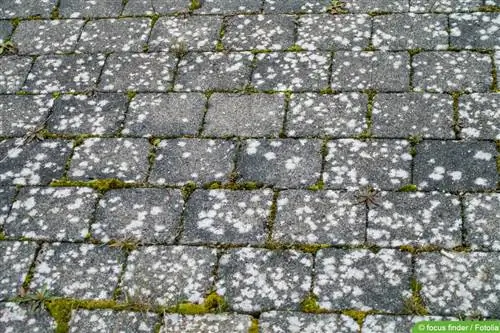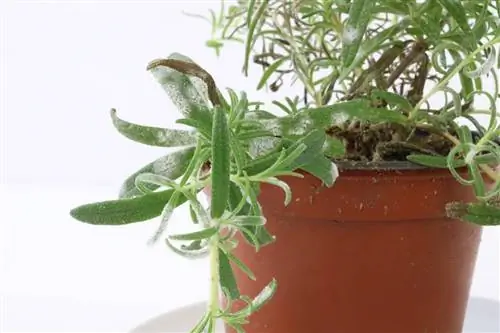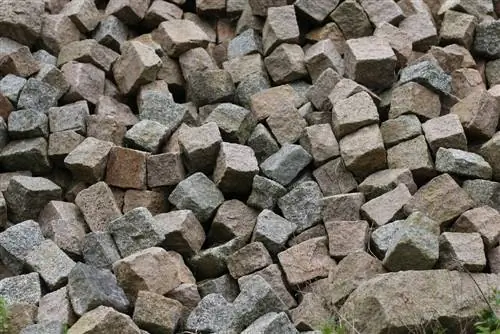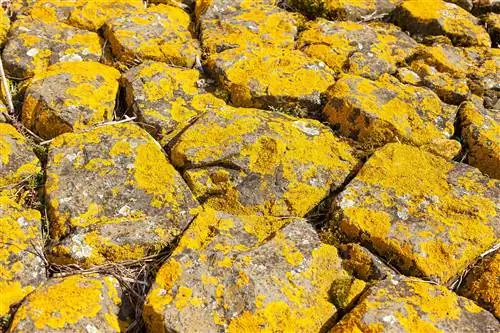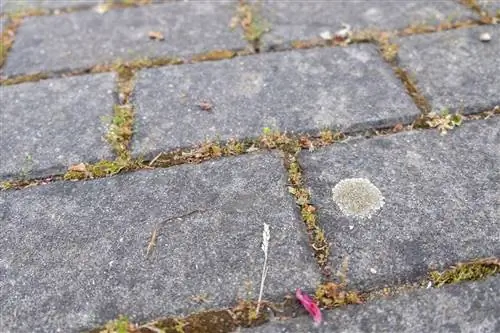- Author admin [email protected].
- Public 2023-12-17 03:39.
- Last modified 2025-01-24 12:45.
If white spots on the concrete pavement don't go away or if they come back regularly, it is most likely a lichen infestation. Although the obscure plants disrupt the overall picture, they can be combated using simple means.
What are lichens?
The lichen, also known as lichenes in botanical jargon, is a symbiosis of photoautotrophic organisms such as algae and fungi. They are often mistakenly referred to as being related to greenery and mosses. In this interaction, the fungus benefits from the products of photosynthesis, while the algae receive minerals, water and protection against drying out.
The coral-like body usually consists of simple crusts or abstract structures that have a wide range of colors. In your own garden they grow on buildings, roof tiles and trees as well as concrete paving and stones. As a rule, overgrown trees do not suffer any disadvantage from the vegetation. In other cases, removal may be worthwhile to prevent damage or for optical reasons.
How do lichens develop on paving stones?
Unlike verdigris or moss, lichens develop in a completely different way. The community of fungus and algae has no roots; it absorbs all nutrients from the air and the subsoil.
Reproduction is carried out via spores, which is very characteristic of fungi. Due to their extremely low weight, spores can be transported by the wind over enormous distances in order to establish a colony at a suitable location. Not least because of this property, removing a lichen is like a Sisyphean task.

Even after removal with a wire brush or scrubber, spores or tiny remnants of the fungus remain. The previously removed fruiting body is quickly recreated. In order for the spores to germinate, only minimal requirements are required. Adequate humidity and good air quality are sufficient for this.
Why is removal necessary?
Overgrown figures or natural stones are not damaged in any way by growth. Sometimes they give overgrown objects an old-romantic charm. However, the spores of the fungi involved can cause he alth problems in sensitive people. In the case of overgrown driveways, terraces and sidewalks, it is also advisable to remove the infestation. In wet weather, the slippery and unsafe surface of lichens when wet poses a significant risk of injury. Last but not least, they synthesize organic acids, which they ultimately secrete into the subsoil. This causes paving stones and other floors to become damaged and crumble. Cracks, stains and various substance damage occur.
Note:
Although lichen growth may provide a romantic aesthetic in some cases, removal is often advisable for safety reasons. Paving stones are particularly susceptible and require regular cleaning to permanently eliminate the infestation, as the rough surface encourages colonization.
Removal materials
There are many different measures to combat stubborn lichen. Depending on the type of removal, different materials are used. Below is a short list of the resources:
- Scrubber
- Wire brush
- Wire broom
- High-pressure cleaner
- Lichen Remover
- baking soda solution
- Biocides
Removing stains from paving stones
There are a variety of ways to stop growth. The procedures include:
Mechanical removal
Mechanical removal with a wire brush or scrubber requires enormous effort and time. Superficial removal is often sufficient if there is only a small infestation. Tools such as high-pressure cleaners work wonders when removing larger accumulations.
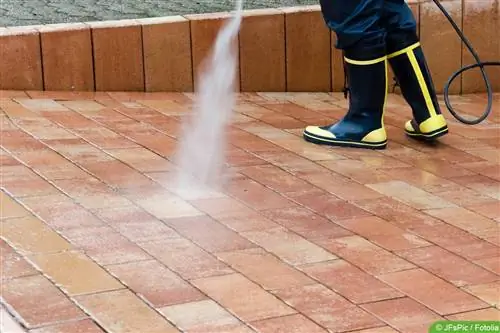
The powerful devices shoot the mushroom from the stones with high pressure. Due to the high pressure, this method can only be used for compact stones. In the case of soft materials such as sandstone or lime, the surface treatment would damage the stone and reveal further areas for moss and lichen to attack.
Home remedies
Home remedies such as baking soda or fruit vinegar can also help with smaller infestations.
Boiling water and baking soda
- The floor must be cleared of any coarse dirt. This can be done with a simple broom.
- Depending on the area, sufficient water should be boiled and poured into a bucket.
- There are now around 30 grams of baking soda powder for every 10 liters of water.
- The solution must now be distributed to the affected areas and take effect.
- After 24 hours, the areas can simply be scrubbed with a wire brush.
- Finally, the floor can be rinsed with water to remove the residue.
Tip:
Natron has two wonderful properties. While it simplifies the removal of the lichen, it also offers long-term protection against the spores and re-emergence.
Wine and fruit vinegar
- Vinegar essence is mixed with water in a 1:10 ratio.
- Spread the solution onto affected areas using a watering can.
- After a short exposure time, the growth can be easily removed with a wire brush.
Tip:
It is simpler and less complicated to use biodegradable green deposit remover. The products from the hardware store contain pelargonic acid and are environmentally friendly.
Care should be exercised when using aggressive home remedies such as a homemade baking soda solution. If these get into the environment, they can cause great damage.
Chemical process
As an alternative, chemical removal is an option. It is based on the use of biocides that provoke decomposition of the structure and destroy fungal spores. Special active ingredients are intended to provide long-term protection for the treated surface and kill any spores that settle. Corresponding products are also freely available in retail stores for private individuals.
What mistakes should you avoid?
Among the numerous methods for combating lichens, there are also some that should be avoided for environmental reasons. Burning off lichens with a commercially available weed burner or conventional gas burner, for example, completely removes lichens, but there is also the risk of damaging useful plants and animals. The treated natural stone can also be damaged by the high heat generated. Even when using a high-pressure cleaner, it is important to test in advance whether the treatment is suitable for the stone floor in question. If the stone floor contains deep joints, the pressure can push the spores deep into the earth and thus accelerate recolonization.
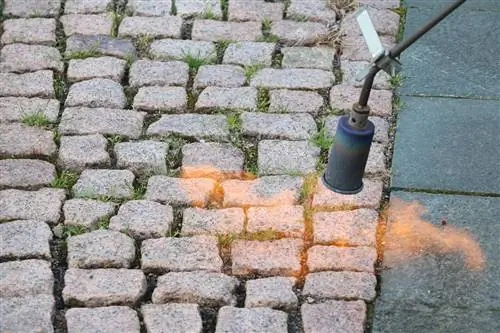
Last but not least, numerous cleaning products advertise that they can completely remove unwanted growths. However, these products often come with numerous risks. The very aggressive ingredients not only damage the environment, but also your own he alth and the surface to be treated.

